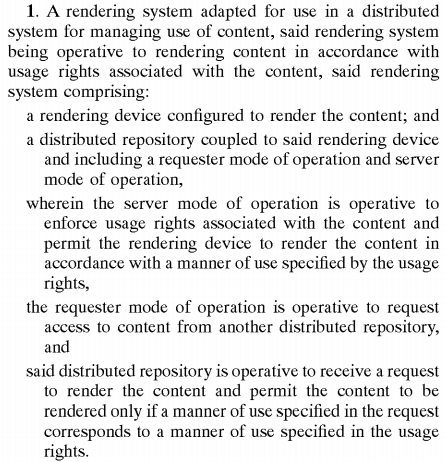Bobbing For Apples: Claim Construction in ContentGuard v. Apple
Jul 25th, 2017 by William Reid | Recent News & Articles |
In a non-precedential, but nevertheless interesting case concerning several patents related to digital rights management for computers and other devices, the Federal Circuit in ContentGuard Holdings, Inc., v. Apple Inc., 2016-1916, 2016-2007 (Fed. Cir. July 12, 2017), agreed with the District Court’s construction of the claims, where both Parties’ proposed constructions had been rejected.1 The suit involved several of ContentGuard’s patents: U.S. Patent No. 6,963,859 (859 Patent), U.S. 7,823,072 (072 Patent), U.S. Patent No. 8,370,956 (956 Patent), U.S. Patent No. 8,393,007 (007 Patent), and U.S. Patent No. 8,001,053 (053 Patent), and alleged infringement by Apple.2 Ultimately, the District Court entered final judgement in favor of Apple.3
The claim construction portion of the case pivoted on the meaning of the term, “usage rights;” for example, as in the 859 Patent:
Following a claim construction hearing, the District Court rejected both Parties’ proposed claim constructions, and instead construed the term, “usage right” to mean:
indications that are attached, or treated as attached, to [a digital work/digital content/content/a digital document].4
In its claim construction, the Federal Circuit began with an examination of the meaning of the words themselves, finding that “[n]either party contends that “usage right” has a plain and ordinary meaning to a PHOSITA.5” The Federal Circuit then looked to the claims and concluded that the claims similarly do not define usage right6. However, the Federal Circuit did find guideposts in the body of the specification, first pointing out that in the Glossary of the 859 Patent, the term “Composite Digital Work” is defined as “[a] digital work comprised of distinguishable parts” that “[e]ach … have usage rights attached.”7 Indeed, quoting the 859 Patent at col. 6, line 11, the Federal Circuit’s view of the patent was that “maintaining the attachment between the usage right and content is ‘[a] key feature of the present invention.”8
This case is interesting because it demonstrates the shear power of the patent specification in construction of the claims. Here, not only does the Glossary serve the purpose of the patent drafter acting as lexicographer, but the specification’s further use of the limiting terminology, that the attachment between the usage right and content was “key.” Such was the importance of the specification that it overrode the proposed claims constructions of both Apple and ContentGuard.
1 Slip Op at 8.
2 Id. at 3.
3 Id.
4 Id. at 8.
5 Id.
6 Id.
7 Id. at 9.
8 Id.
This article is for informational purposes, is not intended to constitute legal advice, and may be considered advertising under applicable state laws. The opinions expressed in this article are those of the author only and are not necessarily shared by Dilworth IP, its other attorneys, agents, or staff, or its clients.

